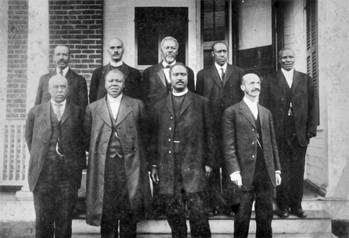African Methodist Episcopal Zion Church
See also: African Americans; Simon Green Atkins; Andrew J. Cartwright; John Campbell Dancy, Jr.; James Walker Hood; Christopher Rush; Herbert Bell Shaw; Owen Lun West Smith; William Jacob Walls; John Taylor Williams.
The African Methodist Episcopal Zion Church (AME Zion Church) traces its roots to 1796, when Peter Williams, Christopher Rush, James Varick, and other African Americans left the white John Street Methodist Church in New York City to form a black church. Five years later, the group was chartered as the African Methodist Episcopal Church ("Zion" was added in 1848). Unable to penetrate the white-dominated South during slavery, the AME Zion Church was primarily a northern institution for decades. It became known as the "freedom church" because of its efforts to help slaves escape from their masters, and because its membership included celebrated black leaders Harriet Tubman, Sojourner Truth, and Frederick Douglass.
After the Civil War, congregations developed in many North Carolina towns, and by the late nineteenth century the AME Zion Church had achieved an important religious status in the state. In 1876 the Star of Zion, its official newspaper, was established to provide news and information on events in local churches, district and annual conferences, evangelistic efforts, educational meetings, and ecumenical participation. Since 1894 the organ has been published in Charlotte, which also is the home of the AME Zion Publishing House. Throughout its more than 125-year history, the Star of Zion has advocated greater citizenship rights and educational and economic opportunities for African Americans, who, the church teaches, carry much of the responsibility for their own progress. Prior to the election of President Franklin D. Roosevelt in 1932, the paper's political orientation had a Republican cast; since then, it has reflected the Democratic view of government as an ally in the fight for justice and equal rights for racial and other minorities.
In the early 2000s, more than 300,000 members of the AME Zion Church worshipped in approximately 600 congregations across North Carolina. The offices of the AME Zion general secretary and the publishing house are located in a Charlotte facility constructed in 1966 to replace a 1911 structure. The church also maintains six institutions of higher learning, including two in North Carolina-Livingstone College and Hood Theological Seminary, both in Salisbury.
References:
David Henry Bradley, A History of the A.M.E. Zion Church (2 vols., 1956-70).
David B. Van Leeuwen, "Saving the White Man's Christianity: William Jacob Walls and Twentieth-Century African American Christianity" (Ph.D. diss., UNC-Chapel Hill, 1995).
William Jacob Walls, The African Methodist Episcopal Zion Church (1974)
1 January 2006 | Williams, Wiley J.